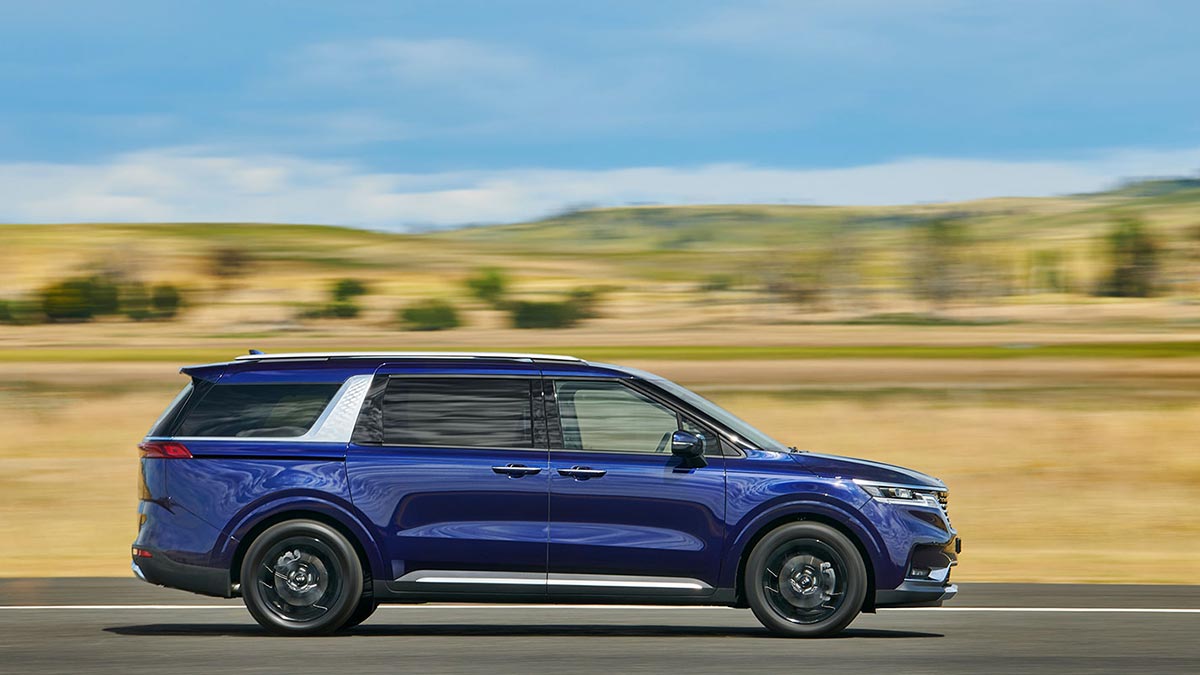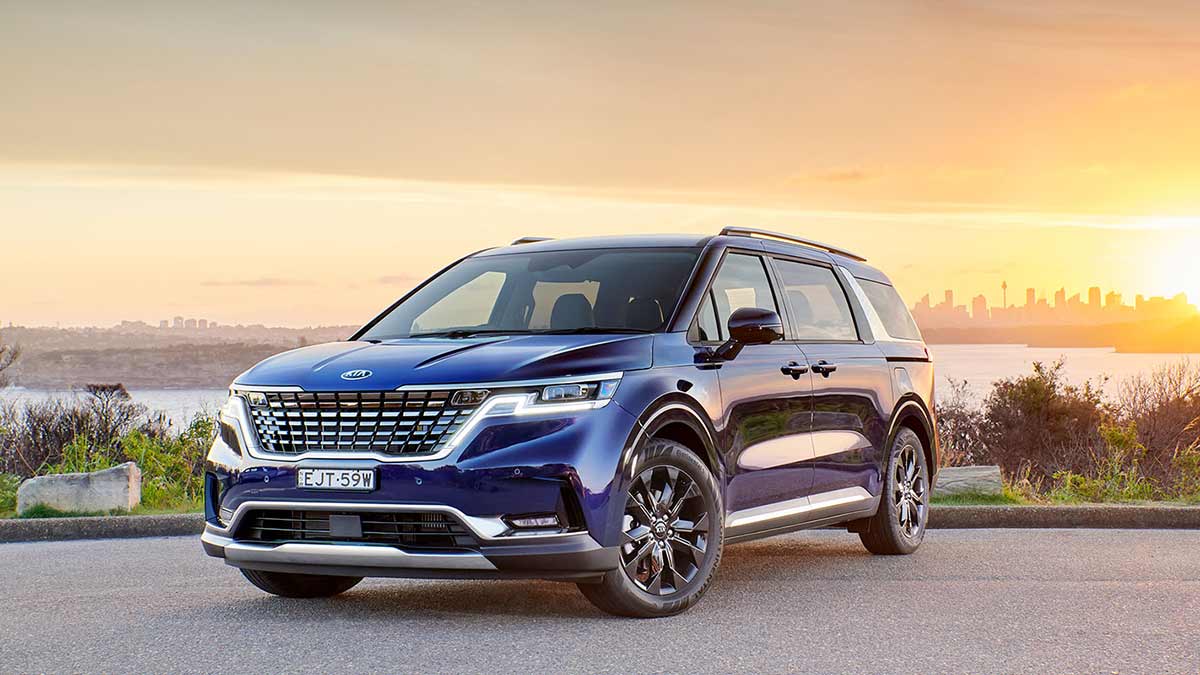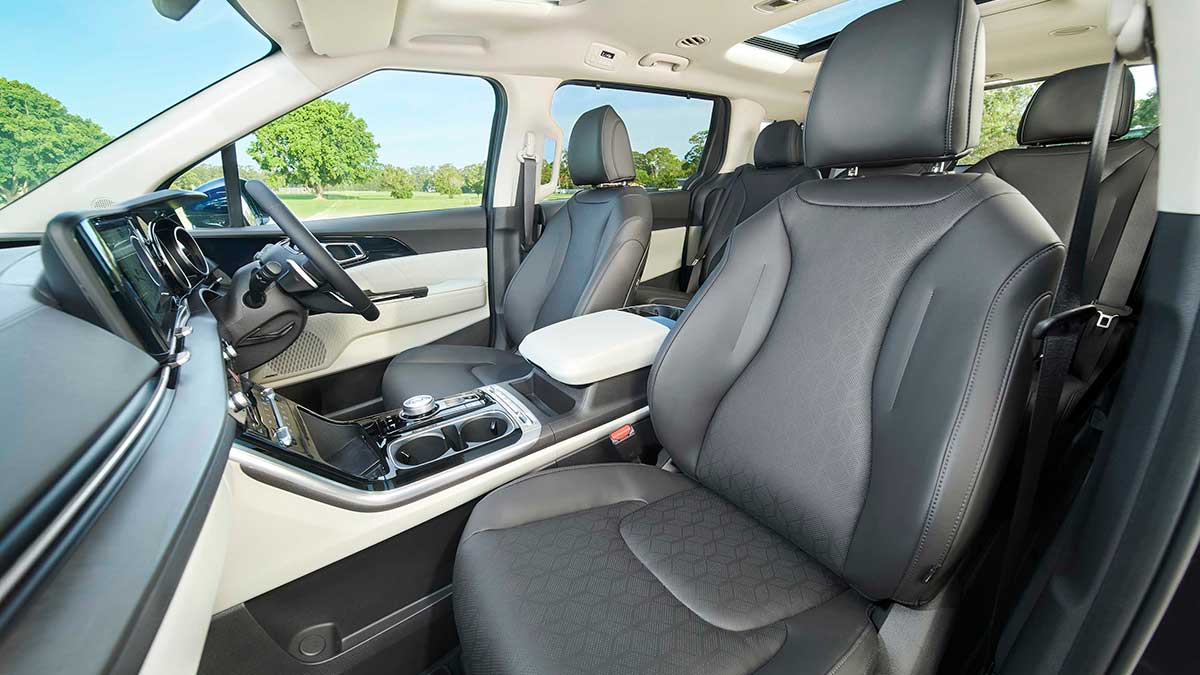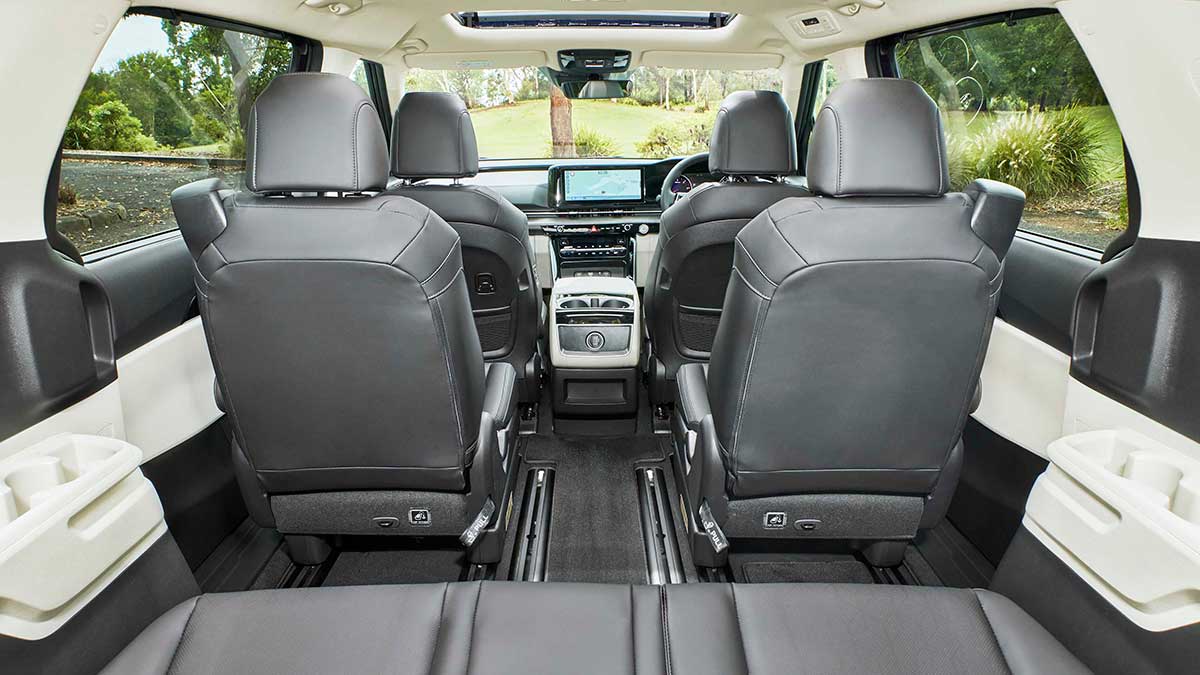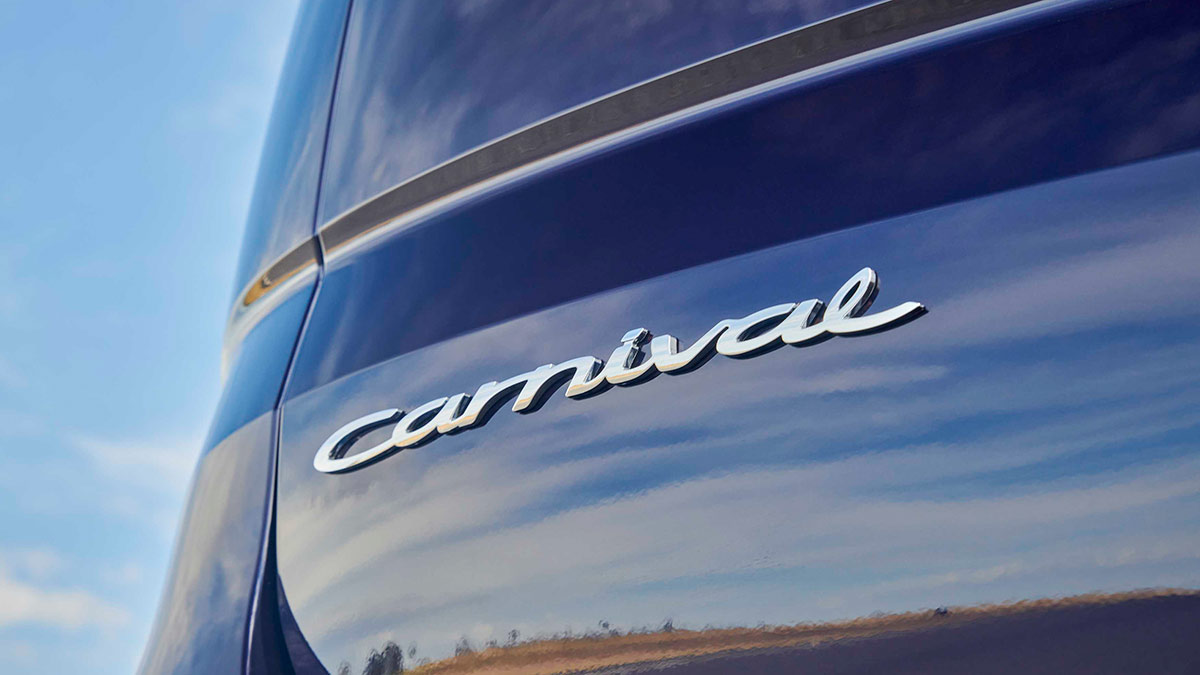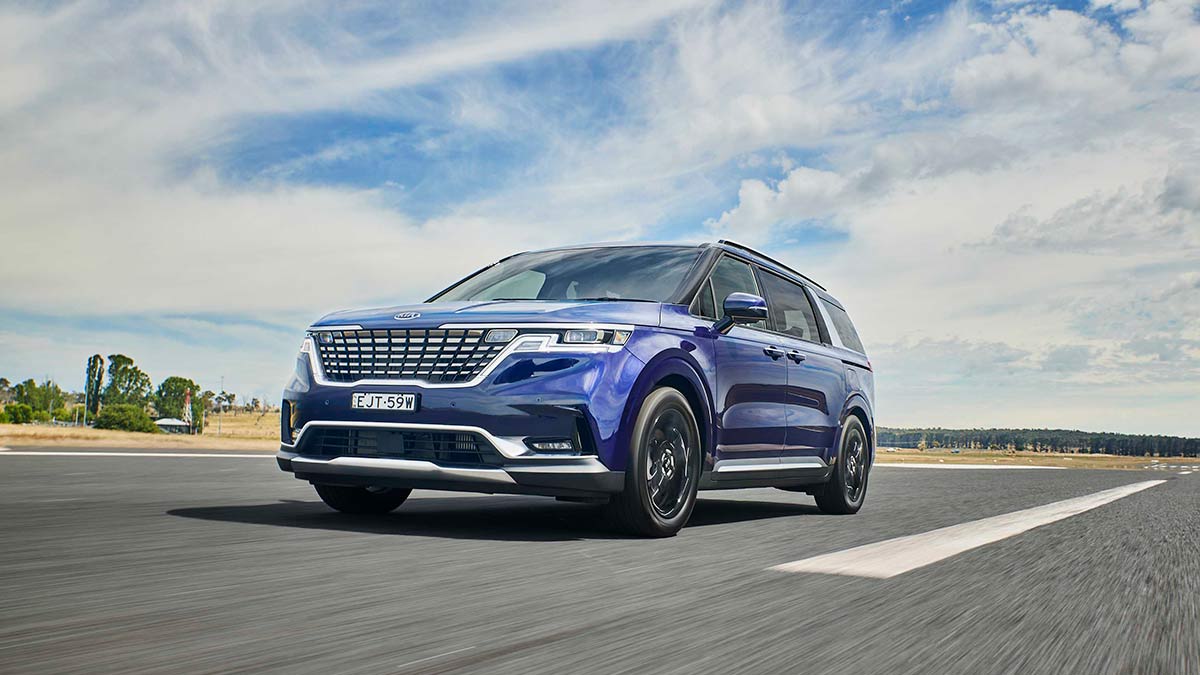The ninth-generation Toyota HiLux has arrived, bringing with it a futuristic forward exterior design, more safety and tech and the same rugged capability owners love. Will the updates tempt private buyers away from the Ford Ranger or are they just enough to keep fleets onside?
Kia Carnival Platinum 2021 road test review

How do you make a people mover sexy? Design it to look like an SUV.
That’s what Kia has done with the fourth-generation Carnival and the result is a striking, modern, and, yes, sexy people mover that’s more than fit for purpose. Can the new Carnival lure buyers away from the increasingly generic batch of seven-seat SUVs? We sampled the flagship Platinum to find out.
Thumbs up
- Clever use of space
- Cavernous interior
- Cargo capacity
- Cossetting ride
- Hushed cabin
- Value for money
Thumbs down
- Windscreen reflection on sunny days
- Touchscreen glitches
- Bottle storage in doors
- Spongy brakes
Price and positioning
Kia has pumped more tech and comfort features into the all-new Carnival and as a result prices are up a little over $3000 per variant compared with the previous model. But it still represents exceptional value given how much car you get for the money.
It’s available in four model grades – S, Si, SLi and Platinum – with prices ranging from $46,880 to $66,680 before on-road costs. Engine choices are a V6 petrol and 2.2-litre turbo-diesel which carries a $2000 premium.
Rivals include Honda’s recently updated Odyssey ($44,250 to $51,150), the ageing Hyundai iMax ($44,930 to $49,480), LDV G10 ($31,809 to $36,355), Volkswagen Multivan ($61,990 to $87,990), Mercedes-Benz V-Class ($84,100 to $98,860) and Toyota Granvia ($64,090 to $75,726). All except the Kia and Honda are based on commercial van platforms so lack the car-like drive experience of the Carnival and Odyssey.
As expected, Kia offers loads of kit as standard across each model grade, and the flagship Platinum tested here is seriously premium, with features you’d expect in a more expensive car.
Safety first
The 2021 Carnival achieved a five-star ANCAP crash safety rating for all variants, with strong results in adult (90 per cent) and child-occupant protection (88 per cent). Safety and driver-assist features are standard on all variants but the higher-grade SLi and Platinum gain some advanced features – nothing that should absolutely be standard on the entry grades.
The lane-keeping aid keeps the vehicle centred without straying too close to line markings. The adaptive cruise control gently slows it to the speed of the vehicle ahead.
The inside story
The new Carnival is 10 millimetres wider and 40 millimetres longer overall, giving it a 30-millimetre-longer wheelbase. That means even more leg, head and shoulder room than its cavernous predecessor.
As well as ample head and leg room, there’s so much space across the front that both occupants can rest their elbows on the armrest without touching. The seats are on the firmer side, without being uncomfortable, and offer decent bolstering for support. There’s a premium feel to the leather and the interior is broken up with splashes of dark grey and cream throughout.
It has a staggering nine cupholders, and as well as a huge central storage bin there’s a wireless charging nook, another slot for a mobile device in the console, and long front door pockets but minimal bottle storage in the doors.
The 12.3-inch central infotainment screen uses Kia’s latest multimedia system with appealing, modern graphics and a user-friendly menu layout. Kia is nailing infotainment these days, although adding a controller in the centre console would help because it’s quite a stretch to reach the touchscreen in such a large car. The display projects views of the reversing camera split with the 360-degree around-view monitor, which is useful when parking. The 12-speaker Bose audio system is top notch.
A couple of niggles, however. At one point on a hot Melbourne day, the central screen failed to activate after starting the car. It happened twice but then righted itself. Not great, but we suspect this is not an ongoing fault. Also, something behind the instrument binnacle reflects light onto the windscreen on sunny days, right in the line of sight.
The Carnival has some clever tech, including a passenger talk function that uses a microphone to capture the driver’s voice and project it through rear speakers, so you don’t have to yell to the third row. There’s a quiet mode that only plays audio through the front speakers – handy if you have sleeping passengers. You can also create a personal profile that saves personal settings for functions like Bluetooth, seating and mirror positions and navigation settings.
The rear sliding door opens simply by standing next to it with the proximity key or by tapping the one-touch button on the handle. To open from inside, just tap the button at the base of the B-pillar.
The flexible second row has three separate seats, and the centre seat is reversible, allowing adults to keep an eye on a baby in from? the rear pew. Note that Australian Design Rules state the seat can be used by an adult or a child, but you can’t fit a child restraint to it while facing rearward. The centre seat also folds flat and has a huge tray, two device slots and a pair of cupholders.
Adding to the flexibility is the flat floor – there is no bulging transmission tunnel so it’s easy to move around the cabin. Seats are flat but comfortable, and there’s ample leg, head and shoulder room, while toe room is limited.
Heated second-row seats are standard on the Platinum and rear occupants can tap a button on the side of the front passenger seat to move it forward for even more leg room. Knee-level and roof-mounted air-con vents, a coat hook, and 12-volt and USB ports on the front seatback all feature in row two.
Even at six foot tall, getting in and out of the third row is a breeze – much less awkward than climbing into the third row of a large SUV. There’s decent leg room for my height and more toe room than in the second row, but head room is slightly tighter. The back row has phone, bottle and cup storage, USB ports, roof vents and speakers. The curtain airbags cover all three rows, too. The Carnival is a genuine eight-seater, but the centre seat in the third row is tight – best kept for kids. Still, we would much rather drive long distances in this than in the third row of any seven-seat SUV.
Even with all three rows in place, the Carnival has an impressive 627-litre capacity in the deep boot, beating every large SUV on the market. This increases to 2785 litres when the 60/40 split-fold third row is stowed flat into the floor. The handle and strap mechanism to pull the seats back into place is clever and lightweight. The Carnival has a temporary spare tyre.
On the road
Two powertrains are available including a 148kW/440Nm 2.2-litre four-cylinder turbo-diesel, and the 216kW/355Nm V6 petrol tested. It’s the same V6 available in the Sorento SUV, but the Carnival gets 16kW more power and 23Nm more torque. Both models share a platform and therefore many of their underpinnings.
The petrol V6 has grunt, but outright performance is blunted by the car’s 2136-kilogram kerb weight. Acceleration from a standing start is more than adequate and there’s enough torque for confident overtaking, but it loses some momentum on steep ascents. There’s some hesitation coming out of corners, but this isn’t the car for cornering. It’s long, weighty and top heavy. It handles better than any of the van-based people movers, but it can’t match its lighter, dynamically engaging Sorento sibling.
The fully independent suspension system has been drastically overhauled for the new-gen Carnival, and as always, Kia Australia’s local tuning team has tweaked the ride and handling to ensure it’s better suited to local conditions.
The results are extraordinary. Ride quality around town is exceptional. It floats over speed bumps and handles corrugations with ease. A stint behind the wheel prompted my partner to say, “it’s like driving on a cloud”. The comfortable ride continues on poor-quality B-roads too, which is impressive given the big 19-inch wheels.
Even when the engine is being pushed, the cabin is quiet on all road surfaces thanks to significant noise, vibration and harshness measures. Steering is weighted on the heavier side but it’s still direct. The brakes are a little doughy.
Kia’s fuel-use figure for the petrol Carnival is 9.6 litres per 100 kilometres and we recorded 10.6 litres after a week of extensive driving.
The verdict
The new Carnival is the most complete people mover we’ve driven. Test drive one before buying that large SUV.
